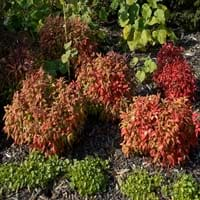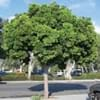Life Span
Perennial
Perennial
Type
Tree
Broadleaf Evergreen
Origin
North America, United States, Northeastern United States, Mid-Atlantic United States, Southeastern United States, North-Central United States, Central United States, South-Central United States, Canada
China, Japan
Types
Autumn Flame, October Brilliance, Tiliford
Heavenly Bamboo, Nandina 'Colerno'
Dwarf Nandina 'Compacta'
Dwarf Nandina 'Filamentosa'
Heavenly Bamboo, Nandina 'Harbor Belle'
Heavenly Bamboo, Nandina 'Moon Bay'
Number of Varieties
Not Available
Habitat
Forests, Wide range of ecological site
low mountains, Mountain tops, Mountains, Valley
USDA Hardiness Zone
3-9
6-11
AHS Heat Zone
9-1
Not Available
Sunset Zone
A2, A3, 1a, 1b, 2a, 2b, 3a, 3b, 4, 5, 6, 7, 8, 9, 14, 15, 16, 17
21,22
Habit
Oval or Rounded
Clump-Forming
Flower Color
Red
Not Available
Flower Color Modifier
Bicolor
Bicolor
Fruit Color
Red, Green, Brown
Not Available
Leaf Color in Spring
Light Green
Green, Purple, Copper
Leaf Color in Summer
Green, Dark Green
Green, Purple
Leaf Color in Fall
Yellow, Red, Orange, Yellow green, Gold, Dark Red, Orange Red
Green, Purple
Leaf Color in Winter
Not Available
Red, Green, Purple
Leaf Shape
Maple shaped
Acuminate
Plant Season
Spring, Summer, Fall
Spring, Summer, Fall, Winter
Sunlight
Full Sun, Partial Sun
Full Sun, Partial Sun, Partial shade, Full Shade
Growth Rate
Medium
Medium
Type of Soil
Clay, Loam, Sand
Loam, Sand
The pH of Soil
Acidic, Neutral, Alkaline
Acidic, Neutral, Alkaline
Soil Drainage
Average
Well drained
Bloom Time
Early Spring, Spring
Not Available
Tolerances
Wet Site, Soil Compaction
Drought
Where to Plant?
Ground
Ground
How to Plant?
Seedlings, Vegetative Reproduction
Seedlings
Plant Maintenance
Medium
Medium
Watering Requirements
Water Deeply, Water when top layer of soil becomes dry
Do not water frequently, Needs less watering
In Summer
Lots of watering
Lots of watering
In Spring
Moderate
Moderate
In Winter
Average Water
Average Water
Soil pH
Acidic, Neutral, Alkaline
Acidic, Neutral, Alkaline
Soil Type
Clay, Loam, Sand
Loam, Sand
Soil Drainage Capacity
Average
Well drained
Sun Exposure
Full Sun, Partial Sun
Full Sun, Partial Sun, Partial shade, Full Shade
Pruning
Remove dead branches, Remove dead leaves
Remove damaged leaves, Remove dead branches, Remove dead leaves
Fertilizers
General garden fertilizer, No need to fertilize every year
All-Purpose Liquid Fertilizer
Pests and Diseases
Anthracnose, Bleeding canker, Decline, Fomes root rot, Ganoderma root rot, Laetiporus root rot, Leaf spot, Powdery mildew, Tar spot, Verticillium Wilt
Red blotch
Plant Tolerance
Soil Compaction, Wet Site
Drought
Flowers
Insignificant
None
Flower Petal Number
Single
Not Available
Foliage Texture
Medium
Fine
Foliage Sheen
Matte
Glossy
Attracts
Not Available
Mealybugs, Whiteflies
Allergy
breathing problems, Eczema, flushing of face, Hives, Low blood pressure, Oral cavity, Rapid Heartbeat, Runny nose, Watery eyes
Not Available
Aesthetic Uses
Showy Purposes
Bonsai, Borders
Beauty Benefits
Not Available
Not Available
Environmental Uses
Air purification, Wildlife
Air purification
Medicinal Uses
Not Available
Antirheumatic, Antitussive, Astringent
Part of Plant Used
Whole plant
Fruits, Leaves
Other Uses
Edible syrup, Used as Ornamental plant
Used for making informal hedge
Used As Indoor Plant
Yes
No
Used As Outdoor Plant
Yes
Yes
Garden Design
Feature Plant, Shade Trees, Street Trees
Container, Edging, Foundation, Groundcover, Hedges, Mixed Border, Topiary, Bonsai, Espalier
Botanical Name
ACER rubrum
NANDINA domestica 'Nana Purpurea'
Common Name
Northern Red Maple, Red Maple
heavenly bamboo
sacred bamboo
nandina
In Hindi
लाल मेपल के पेड़
Dwarf Nandina
In German
Red Maple Tree
Dwarf Nandina
In French
Red Maple Tree
Nandina Dwarf
In Spanish
Árbol de arce rojo
Nandina enana
In Greek
Red Maple Tree
Dwarf Nandina
In Portuguese
Árvore de bordo vermelho
Nandina do anão
In Polish
Red Maple Tree
Dwarf Nandina
In Latin
Rubrum Maple ligno
Dwarf Nandina
Phylum
Magnoliophyta
Tracheophyta
Class
Magnoliopsida
Magnoliopsida
Order
Sapindales
Ranunculales
Family
Aceraceae
Berberidaceae
Clade
Angiosperms, Eudicots, Rosids
Angiosperms, Eudicots
Tribe
Not Available
Not Available
Subfamily
Not Available
Not Available
Number of Species
Not Available
Not Available
Properties of Red Maple Tree and Dwarf Nandina
Wondering what are the properties of Red Maple Tree and Dwarf Nandina? We provide you with everything About Red Maple Tree and Dwarf Nandina. Red Maple Tree doesn't have thorns and Dwarf Nandina doesn't have thorns. Also Red Maple Tree does not have fragrant flowers. Red Maple Tree has allergic reactions like breathing problems, Eczema, flushing of face, Hives, Low blood pressure, Oral cavity, Rapid Heartbeat, Runny nose and Watery eyes and Dwarf Nandina has allergic reactions like breathing problems, Eczema, flushing of face, Hives, Low blood pressure, Oral cavity, Rapid Heartbeat, Runny nose and Watery eyes. Compare all the properties and characteristics of these two plants. Find out which of these plant can be used as indoor plant. If you are interested to decorate your house and garden, find out aesthetic uses, compare them and select the plant which will beautify your surrounding. Along with beautification, try comparing medicinal and edible uses of Red Maple Tree and Dwarf Nandina and you can choose the plant having best and most benefits.
Season and Care of Red Maple Tree and Dwarf Nandina
Season and care of Red Maple Tree and Dwarf Nandina is important to know. While considering everything about Red Maple Tree and Dwarf Nandina Care, growing season is an essential factor. Red Maple Tree season is Spring, Summer and Fall and Dwarf Nandina season is Spring, Summer and Fall. The type of soil for Red Maple Tree is Clay, Loam, Sand and for Dwarf Nandina is Loam, Sand while the PH of soil for Red Maple Tree is Acidic, Neutral, Alkaline and for Dwarf Nandina is Acidic, Neutral, Alkaline.
Red Maple Tree and Dwarf Nandina Physical Information
Red Maple Tree and Dwarf Nandina physical information is very important for comparison. Red Maple Tree height is 1,220.00 cm and width 1,220.00 cm whereas Dwarf Nandina height is 30.00 cm and width 60.00 cm. The color specification of Red Maple Tree and Dwarf Nandina are as follows:
Red Maple Tree flower color: Red
Red Maple Tree leaf color: Light Green
Dwarf Nandina flower color: Not Available
- Dwarf Nandina leaf color: Green, Purple and Copper
Care of Red Maple Tree and Dwarf Nandina
Care of Red Maple Tree and Dwarf Nandina include pruning, fertilizers, watering etc. Red Maple Tree pruning is done Remove dead branches and Remove dead leaves and Dwarf Nandina pruning is done Remove damaged leaves, Remove dead branches and Remove dead leaves. In summer Red Maple Tree needs Lots of watering and in winter, it needs Average Water. Whereas, in summer Dwarf Nandina needs Lots of watering and in winter, it needs Average Water.





